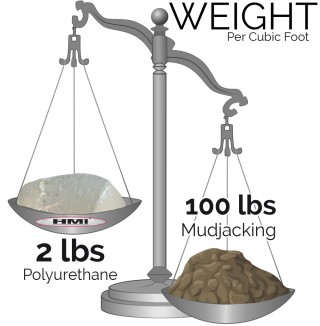Frequently Asked Questions
How much does concrete raising cost?
Concrete raising is typically about half the cost of replacing the same concrete. Ultimately, the cost of raising or stabilizing concrete is a direct reflection of how much leveling material the project will require.
How far the slab is settled, if there are voids present, or if other sections need to be involved in the repair, will determine where in that scale the job would cost. This is why we offer FREE estimates, so our experienced crew member can come to your home or business, and provide you with an accurate estimate for completing your specific project.


What is Mudjacking? Mudjacking material is a sand based grout that will not lose its density. Combined with Portland cement this non-organic mixture is pumped under the slab of concrete.
Will there be heavy trucks on my lawn?

LARA'S CONCRETE SOLUTIONS van remains parked on the street, while the concrete repair crew maneuvers the equipment to the site requiring repair.
Our polyurethane hose is ran straight from the van to the repair site without driving a single piece of equipment on your lawn.
How do you fill the holes?

After the concrete is raised with our polyurethane foam material. We seal all our holes with a Commercial-Grade Waterproof Silicone and sand for matching texture of the concrete. The concrete is ready for use immediately. However, it is recommended to allow the patch material to set-up before use, typically a couple of hours.
What Can be Raised/Repaired?
Solid slabs of concrete can be raised and stabilized. Gravel areas or blacktop are unable to be repaired, and need to be replaced or re-installed to remedy settling issues. Slabs of concrete that are badly cracked may also be too damaged to lift. (If you are unsure don't hesitate to reach out to us!)
We LIFT IT ALL!
-Sidewalks
-Driveways
-Pool Decks
-Footings
-Patios
-Garage floors
-Basement floors
-Office floors
-Warehouse floors
-Highways
-Bridge Approaches
-Seawall Repair
-Voids
If you are not sure if your concrete can be raised, call us for a Free Estimate. Raising settled concrete can be half the cost of replacing it with less damage to your landscaping and downtime. Our expert estimators will be able to assess and provide you with an accurate, FREE estimate for your project.
What is the difference between Mudjacking and Polyurethane Concrete Raising?

Material
Settled concrete is commonly a result of poor soil conditions beneath a slab.
Polyurethane has become a popular repair method because the material is so lightweight compared to traditional mudjacking material, it will not further burden the already weak soil.
Mudjacking uses a sand based material that is infused with Portland cement. This slurry is hydraulically pumped under the slab to fill voids and raise the concrete. Mudjacking material weighs on average 100 lbs per cubic foot.


After the slab has been raised, the only visible evidence that the concrete has been repaired are the holes. For this reason, polyurethane has gained HUGE popularity because of the nearly invisible 3/8″ - 5/8" holes that remain after the job is completed.
Mudjacking involves drilling a series of 1″-2" holes in a slab of concrete, so the material can be pumped under the settled slab.
Polyurethane concrete raising drills a nearly invisible 3/8" 5/8″ hole and the process calls for considerably fewer holes than traditional mudjacking.
